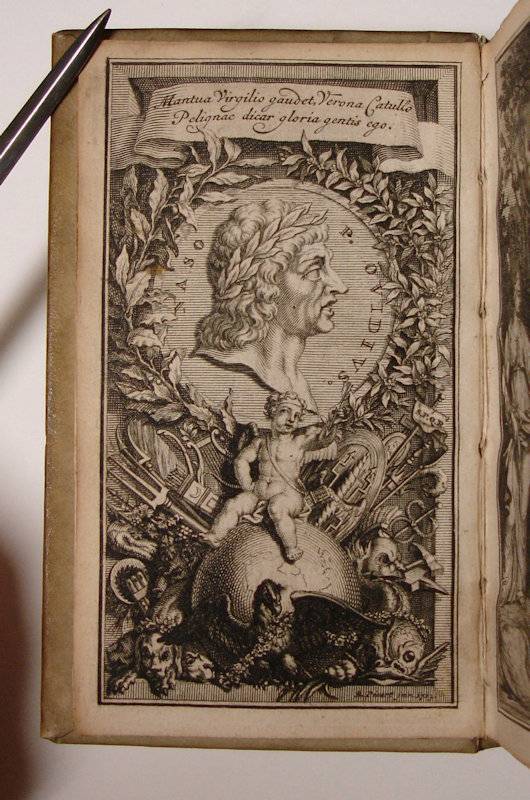OVIDIUS.
Publii Ovidii Nasonis Opera. Petrus Burmannus ad fidem veterum exemplarium castigavit.
Ad 1: Amsterdam (Amstelaedami), Apud Rod. & Gerh. Wetstenios H. FF., 1713. Ad 2 & 3: Utrecht (Trajecti Batavorum, Apud Guilielmum vande Water, 1713)
12mo. 3 volumes: (LXII),302; 340,XVII,(1 blank);370 p., portrait and frontispiece. Vellum 13.5 cm (
Ref: Schweiger 2,631: 'Heinsius Text liegt zum Grunde, ist aber nach Handschriften verbessert. Sehr correct'; Graesse 5,70; Ebert 15370; Brunet 4,273) (
Details: Portrait of Ovid by the French engraver Bernard Picart: Ovid's medallion portrait is surrounded by laurel branches, beneath Ovid sits Amor on the globe. The frontispiece, also by Picart, depicts a bucolic scene: the poet sits at the border of a pond, flanked by the Muse Erato, who holds a laurel wreath above his head, and a crowned female figure, who has a long trumpet in her right hand. (Fama?) Above them hovers Amor who just has wounded the poet with two arrows right in his chest. Woodcut printer's mark on the title of the 2nd and 3rd volume, depicting Fama hovering above a city, the motto is: 'Pax artium altrix'. Volume 2 and 3 also have 5 thongs laced through the joints. The joints of the first volume are smooth and without laces. Nevertheless the 3 volumes form a set, for they have the same manuscript title on the back) (
Condition: Vellum age-toned and soiled. Small piece of paper of 7 mm deep gone from the outer margin of the first title) (
Note: The Roman poet Ovid, 43 B.C. - 17 A.D, 'is perhaps the most consistently influential and popular writer of the classical tradition. His central position is suggested by the many surviving manuscripts of his works and their early publication in printed editions. (...) Most would agree that it is his Metamorphoses that has had the greatest influence, but his other major poems, the Heroides, Tristia, Fasti, and particularly his racier works, the Amores, Ars amatoria, and Remedia amoris, have played their part in maintaining his reputation as a writer of enduring importance and appeal.' (The Classical Tradition, Cambr. Mass. 2010, p. 667) Ovid was widely read in antiquity, and remained to be read at the Carolingian court in the Middle Ages. The 12th/13th centuries are even called the 'aetas Ovidiana', for Ovid's love elegy was one of the mainsprings of the phaenomenon of courtly love and its literary expression. His 'Ars amatoria' and the 'Remedia' became even part of the school curriculum. Ovid became also the favourite poet of the Renaissance. Boccaccio and Petrarca were influenced by him. Shakespeare was inspired more by Ovid than by Vergil. (Neue Pauly 9,110/119) The huge number of editions and translations suggests that Ovid's appeal lies also beyond the bounderies of the scholarly and literary world. The site 'Ovid Illustrated' by D. Kinney and E. Styron offers a huge collection of engravings that were made by 16th/17th/18th century artists for the Metamorphoses. The last fourty years have seen a huge increase in attention to Ovids poetry.
§ This is the first edition of the works of Ovid produced by the Dutch classical scholar Pieter Burman, in Latin Petrus Burmannus, 1668-1741. He tells in the preface to this edition (leaf *8) that he follows the
editionum emendatissimam Elsevier edition of Nicolaas Heinsius of 1658-1661. He found it however necessary to restore the text, where Heinsius's conjectures were groundless and too bold. In the preface he also announces a more ambitious edition of Ovid, 'quae brevi sequetur', with notes of him and of other learned predecessors. This augmented and corrected four volume edition, which long remained the standard edition, was published fourteen year later by Burmannus in 1727. Petrus Burmannus was professor of Eloquence (Latin) at the University of Utrecht from 1696, and was transferred to Leiden in 1715. As an editor he confined himself to the Latin classics, such as Phaedrus, Horace, Claudian, Ovid, and Lucan. 'His numerous editorial and critical works spread his fame as a scholar throughout Europe, and engaged him in many of the stormy disputes which were then so common among men of letters. Burman was rather a compiler than a critic; his commentaries show immense learning and accuracy, but are wanting in taste and judgment'. (Wikipedia 'Pieter Burman the Elder') (
Provenance: On the front flyleaf of the 3rd volume a name: 'Groenman') (
Collation: Ad 1: pi1, *-2*12, 3*6 (leaf 3*6 blank), A - M-12, N-8 (minus leaf N8). Ad 2: A-O12, P12 (leaf P11 verso & leaf P12 blank). Ad 3: a-p-12, q6 (minus leaf q6)) (Photographs on request)
Book number: 120112 Euro 300.00
Keywords: (Oude Druk), (Rare Books), Dichtkunst, Latin literature, Ovid, Ovidius, antike altertum antiquity, poetry, römische Literatur
 OVIDIUS.
OVIDIUS.